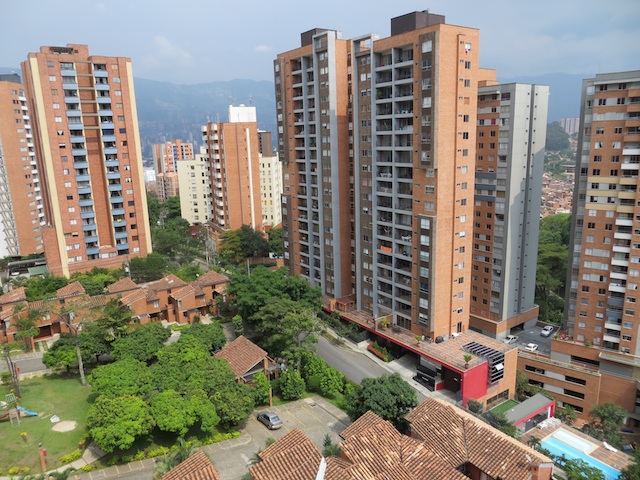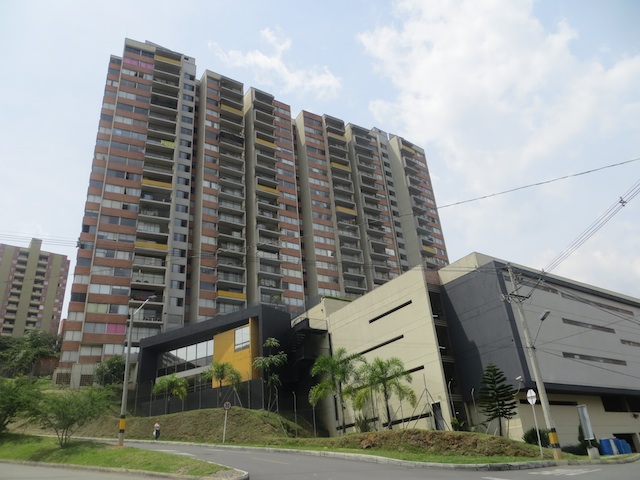
Editor’s Note: This is the second in a four part series. Read the first post here.
Part two in this series looks at my experience in furnishing my first apartment in Medellín as well as setting up utilities. In addition, after a year in my first apartment, I made the decision to move to a high-rise apartment.
My move to a high-rise apartment is the second example rental in this four-part guide to renting apartments in Medellín.
After receiving keys to my first unfurnished apartment in Medellín, the first thing I did was call one of the locksmiths in the yellow pages to come out and change the locks. After that I immediately started to furnish the apartment.
With my first apartment being located in Estadio, it turned out that many stores with apartment furnishing were located nearby.
Near the Suramericana metro stop (two metro stops away) I shopped at Carrefour (now a Jumbo) to buy a refrigerator, washing machine and television. Both the Jumbo and Exito big box retailers in Medellín regularly have appliance and television sales and you can get good deals.

I shopped at small furniture stores on Ochenta (near the Fatima metro station) three blocks from the apartment, which are shops that sell locally produced Colombian furniture and this is where I bought an inexpensive sofa and kitchen table and chairs.
I discovered near the Homecenter store near the Suramericana metro stop several small mattress stores that sell mattresses about 40 to 50 percent cheaper than found in the mattress shops in the big malls in Medellín, plus you can bargain.
For items like dishes, pots and pans, towels and curtains, I shopped at Jumbo and Homecenter.
Here are actual prices I paid for some of the furnishings to get an idea of costs in Medellín:
- Haceb fridge – 1,039,000 pesos ($551)
- Haceb wash machine – 859,000 pesos ($456)
- Queen size pillow top mattress plus bed stand – 990,000 pesos ($525)
- Sofa – 460,000 pesos ($244)
- Kitchen table and 4 chairs – 550,000 pesos ($292)
- 32” Samsung TV – 729,900 pesos ($387)
- Desk and chair – 150,000 pesos ($80)
Setting up utilities
It turns out you don’t have to do anything to set up electric, gas and water services. These are provided by EPM, the local government owned utility, and are established by the apartment owner and put in the apartment owner’s name.
Most rental contracts stipulate the tenant pays the EPM bill. The bill arrives monthly and you can pay in cash at a local grocery store like Exito.
Getting Internet, television and phone service is a different story. There are three triple-play service providers in Medellín: Claro, UNE and Movistar.
Per my real estate agent, the new apartment I had rented was supposed to have service from both Claro and UNE. But when I checked with Claro, they didn’t yet have service to this new building in Estadio.
So my only option was UNE. But when I went to UNE they said I needed a Colombian cedula to establish services, which I didn’t yet have.
Fortunately my Colombian girlfriend at the time was willing to get UNE service in the apartment set up under her name and a few days later I had triple play service in my new apartment.

After a year – decided to move
I enjoyed living in Estadio, where I was close to the metro providing easy and inexpensive access to the city as well as being close to the La 70 nightlife and the city’s professional fútbol stadium where I started enjoying going to Atlético Nacional games.
But I started getting tired of walking up stairs to the fifth floor apartment, as the building didn’t have an elevator. The apartment had a small balcony but with not much of a view and I wanted a better view.
I also travel frequently and didn’t feel very comfortable leaving the apartment for a month or more. The building didn’t have 24×7 security that is found in most high-rise apartments in Medellín, it was simple key-access to the building.
I decided to start looking for a new apartment as I approached the end of a year of renting. I started looking for apartments in Laureles/Estadio, Belén and Envigado. But like my first apartment rental I was again challenged by the fiador requirement.
The real estate agent I had used for my first apartment was no longer working so I was dealing with new agents. And each agent I talked to said a fiador was required, even if I paid rent in advance.
After a couple weeks, in total frustration, I decided to run an ad in the local paper saying that I was a foreigner looking for an apartment without a fiador but was willing to pay six to twelve months in advance.
I received calls from a couple of apartment owners willing to rent to me directly without an agent. But when I went to see these apartments they weren’t what I was looking for.
After running the ad for several days, I received a call from a real estate agent in Bello who said he could rent to me without a fiador and that he had many apartments to show me.

This agent drove me around and showed me apartments in Laureles and several barrios in Belén. The third apartment he showed me essentially met all of my requirements, which was located in Loma de Los Bernal in Belén.
This apartment was located far from the metro in a residential area, but within walking distance to an Exito. However I liked the location as it was quiet and further up a hill so it was cooler during the day with nice breezes.
I decided to lease this apartment in a similar deal as my first apartment, paying six months in advance. The lease terms were very similar to my first apartment so I suspect they are pretty standard in Colombia.
My second apartment specifications:
- 3 bedrooms, 2 bathrooms, about 78 square meters (840 square feet)
- Kitchen with gas cooktop and granite counters
- 15th floor with balcony in a high-rise with 24×7 security
- Pool and small gym in building
- Estrato 5 neighborhood
- Cost: 1,200,000 peso per month – 60,000 pesos per month for a parking space I rented out = 1,140,000 pesos ($605) per month net.
Part three of this series will look at my search for a third apartment. After more than a year of living in my second apartment in Medellín I unfortunately had to move again as the apartment owner was returning to Medellín after living in Bogotá.
The owner wanted the apartment back, which forced me to quickly hunt for my third and current apartment in Medellín.












That is certainly a lot cheaper than Cartagena.
Hi Daniel,
Yes, Medellín is a cheaper place to live than Cartagena or Bogotá. You can save money living in Medellín, so you can afford the occasional excursion to Bogotá to indulge in the cultural experiences in the bigger city. Or the occasional excursion to Cartagena for the history, music and nightlife, restaurants and Caribbean coast. Bogotá is an easy 25-minute flight and Cartagena is an hour flight from Medellín.
Dave, Your more “paisa” than me. I left ” El Poblado ” 55 years ago but you kept me well informed. For instance l learned today the regulations about transferring MONEY to Colombia.
Thanks,
Frank
(my american name)
Thanks Frank, but this post was actually written by one of our new writers, Jeff 🙂
Great article ! Can you explain to this gringo what a “fiador” is ?
Thanks
Tom
Hi Tom, fiador was explained in part one of this Apartment Rental Guide series (click on the link at beginning of this post). A fiador is a cosigner who guarantees the tenant’s rent payments so a real estate agent can go after the fiador if the tenant stops paying rent.
My understanding is that a fiador must be a real estate property owner in Colombia. I am aware that fiadors are also used in other countries in Latin America, such as Brazil, Mexico and Peru.
How did you move all your furniture when you left the apartment and how much did it cost?
I used a professional mover, which used furniture wraps. I recall the cost was 350,000 pesos, which was somewhat more expensive than my second apartment move, which was a much shorter distance. The cost was 270,000 pesos for my move from second to third apartment.
Both sound cheap by major US city standards.
Jeff, requiring a Fiador seems to be a nightmare. Can foreigners who own property be my Fiador? Do you need a Fiador for both furnished and unfurnished apartments? Are their lawyers or bankers who will act as Fiadors? Is it easy to find translators and what is the cost? I don’t like signing any contracts let alone one is Spanish. How is the supply and demand for apartments? I don’t enjoy moving….how much notice is required by the owner? I noticed you bought a refrigerator, washer, bed, couch etc. May I assume you hired movers to move your stuff from one place to another? Do you own a place now? How did you meet your wife? Do you both speak English or Spanish? Sounds like finding a Colombian woman makes life easier. With limited Spanish where do you meet los mujeres and do they like Americans. I lived in Panama and many Panamanian woman preferred Americans.